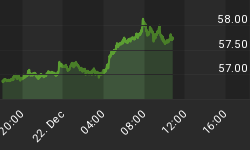It is often stated that copper is the metal with a Ph.D. in economics, and the data for the most part bears this out.
Figure 1 is a monthly chart of copper (cash data) with NBER dated recessions noted by the indicator in the lower panel. With the indicator in the down position, the US economy is in recession; when the indicator is up, the US economy is expanding. As can be appreciated, copper does better during economic expansions. The metal typically peaks during recessions before heading into a down trend (see vertical gray bars).
Figure 1. Copper v. NBER recessions/ monthly
Presently, copper is under performing the broader market, and as we can see from the weekly chart (see figure 2, cash data), copper gap below its 40 week moving average last week, and it is making a lower high. The weakness in copper should be respected, but there is more to the story.
Figure 2. Copper/ weekly
The next graph (figure 3) is a weekly chart of copper (cash data). In the lower panel, is the "Bullish Consensus" data for copper from MarketVane. According to the MarketVane website, "the Bullish Consensus measures the futures market sentiment each day by following the trading recommendations of leading Commodity Trading Advisors." Many investors view the MarketVane data (and sentiment data in general) as helpful in identifying market turning points. For the most part, this is true as we have seen many times how too many investors on one side of a trade often leads to a strong reaction in the opposite direction. But sentient data also has other uses that few rarely speak of, and this has to do with trend following. In essence, as prices of an asset rise so does the degree of bullishness, and as prices fall, investors become more bearish. So what good is following investor sentiment if it just tracks price? My research shows that investor sentiment leads price by about a week or two, so investor sentiment is a good tool at identifying changes in a trend that do not occur at the extremes. Let me give some examples.
Figure 3. Copper v. MarketVane Bullish Consensus/ weekly
Figure 4 shows how investor sentiment leads price. Once again, this is a weekly chart of copper (cash data) with the Bullish Consensus for copper in the lower panel. The black dots represent swing pivot points. Now if we look at the current Bullish Consensus value and compare this value to past swing pivot points, we can make the statement that a close below three swing pivot points is bearish. As you can see, this was the the case in 2006 and in 2008. (This also happens to be the case across time and other asset classes.) When the Bullish Consensus value closed below 3 prior swing pivot points, copper dropped rather precipitously. (As an aside, I am drawing upon my research with pivot points, and I have previously presented similar findings in a SP500 trend following strategy; click HERE to go to that article.) So a close below 3 pivot points is generally bearish, and since sentiment tracks price and as sentiment often precedes price in time, this is an ominous sign.
Figure 4. Copper/ weekly
Now let's move our chart forward in time and look at the past 2 years. See figure 5. At point #1, the Bullish Consensus value closed below 3 swing pivot points. Rather than sell off, this marked the low point for copper before it reversed strongly higher. 8 weeks later, Federal Reserve Chairman Bernanke mentioned QE2 at his speech at Jackson Hole. At point #2, this breakdown nearly marked the high point for copper back in April, 2011. Point #3 was the break down back in September, 2011. Rather than lead to a break down in price, this also marked a bottom. This also happened to coincide with the Federal Reserve's Operation Twist and with the European Central Bank's LTRO. Lastly, turn your attention to the "?????". The Bullish Consensus has closed below 3 swing pivot points. While this normally would be interpreted bearishly, one could easily speculate, based upon the recent past, that central bank intervention is imminent.
Figure 5. Copper/ weekly
So what have we learned from Dr. Copper today?
One. Copper generally peaks during recessions.
Two. Copper is currently putting in a lower high and is trading below its 40 week moving average; copper peaked over 1 year ago.
Three. Investor sentiment not only tracks price but it often precedes it by a couple of weeks. The current price structure for the Bullish Consensus is bearish.
Four. Recent bearish patterns in the price structure of the Bullish Consensus have been bullish owing to central bank intervention. In essence, central banks have prevented a recession from unfolding.
Five. It should noted that each central bank intervention has provided less and less benefit to the markets. When looking at copper, we see that Operation Twist did not produce gains that were seen during QE2. It's as though the markets have become resistant to the effects of monetary stimulation.
Lastly and most importantly. What's next for copper and the markets? The breakdown in the price structure of the Bullish Consensus for copper strongly suggests lower prices for copper, which in all likelihood implies a recession. Central bankers have been timely in their implementation of recent quantitative easing, and we could easily make the case that their interventions have thwarted the onset of a recession on more than one occasion. Copper will need to reverse from the current levels and investors will need to embrace that risk. This will be heralded by a reversal in the Bullish Consensus. Will central bankers be able to save the day again?















